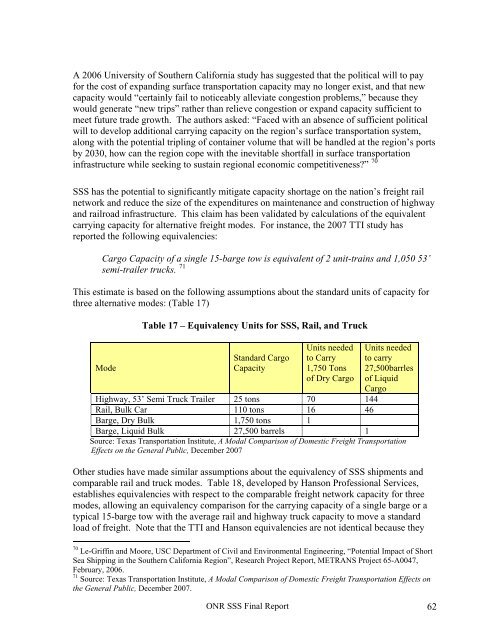Office of Naval Research - National Transportation Library
Office of Naval Research - National Transportation Library
Office of Naval Research - National Transportation Library
You also want an ePaper? Increase the reach of your titles
YUMPU automatically turns print PDFs into web optimized ePapers that Google loves.
A 2006 University <strong>of</strong> Southern California study has suggested that the political will to payfor the cost <strong>of</strong> expanding surface transportation capacity may no longer exist, and that newcapacity would “certainly fail to noticeably alleviate congestion problems,” because theywould generate “new trips” rather than relieve congestion or expand capacity sufficient tomeet future trade growth. The authors asked: “Faced with an absence <strong>of</strong> sufficient politicalwill to develop additional carrying capacity on the region’s surface transportation system,along with the potential tripling <strong>of</strong> container volume that will be handled at the region’s portsby 2030, how can the region cope with the inevitable shortfall in surface transportationinfrastructure while seeking to sustain regional economic competitiveness?” 70SSS has the potential to significantly mitigate capacity shortage on the nation’s freight railnetwork and reduce the size <strong>of</strong> the expenditures on maintenance and construction <strong>of</strong> highwayand railroad infrastructure. This claim has been validated by calculations <strong>of</strong> the equivalentcarrying capacity for alternative freight modes. For instance, the 2007 TTI study hasreported the following equivalencies:Cargo Capacity <strong>of</strong> a single 15-barge tow is equivalent <strong>of</strong> 2 unit-trains and 1,050 53’semi-trailer trucks. 71This estimate is based on the following assumptions about the standard units <strong>of</strong> capacity forthree alternative modes: (Table 17)ModeTable 17 – Equivalency Units for SSS, Rail, and TruckStandard CargoCapacityUnits neededto Carry1,750 Tons<strong>of</strong> Dry CargoUnits neededto carry27,500barrles<strong>of</strong> LiquidCargoHighway, 53’ Semi Truck Trailer 25 tons 70 144Rail, Bulk Car 110 tons 16 46Barge, Dry Bulk 1,750 tons 1Barge, Liquid Bulk 27,500 barrels 1Source: Texas <strong>Transportation</strong> Institute, A Modal Comparison <strong>of</strong> Domestic Freight <strong>Transportation</strong>Effects on the General Public, December 2007Other studies have made similar assumptions about the equivalency <strong>of</strong> SSS shipments andcomparable rail and truck modes. Table 18, developed by Hanson Pr<strong>of</strong>essional Services,establishes equivalencies with respect to the comparable freight network capacity for threemodes, allowing an equivalency comparison for the carrying capacity <strong>of</strong> a single barge or atypical 15-barge tow with the average rail and highway truck capacity to move a standardload <strong>of</strong> freight. Note that the TTI and Hanson equivalencies are not identical because they70 Le-Griffin and Moore, USC Department <strong>of</strong> Civil and Environmental Engineering, “Potential Impact <strong>of</strong> ShortSea Shipping in the Southern California Region”, <strong>Research</strong> Project Report, METRANS Project 65-A0047,February, 2006.71 Source: Texas <strong>Transportation</strong> Institute, A Modal Comparison <strong>of</strong> Domestic Freight <strong>Transportation</strong> Effects onthe General Public, December 2007.ONR SSS Final Report 62
















